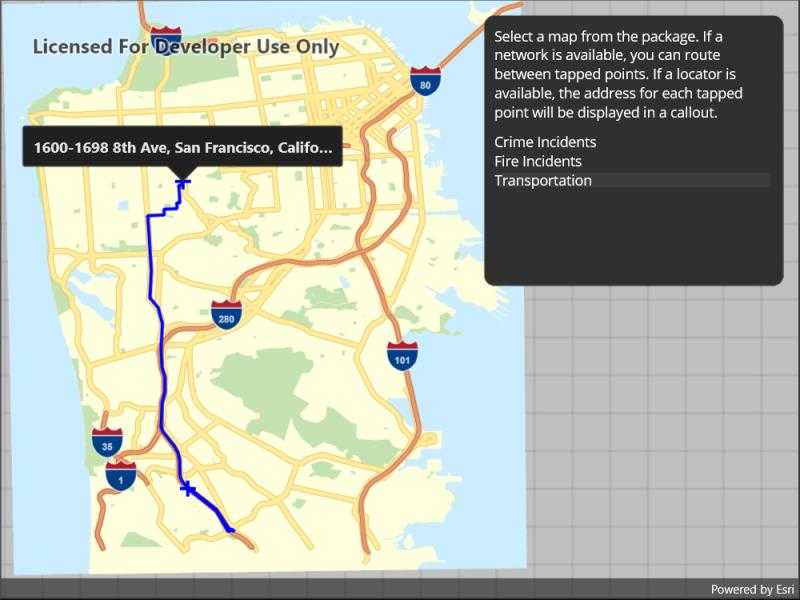Display maps and use locators to enable search and routing offline using a Mobile Map Package.

Use case
Mobile map packages make it easy to transmit and store the necessary components for an offline map experience including: transportation networks (for routing/navigation), locators (address search, forward and reverse geocoding), and maps.
A field worker might download a mobile map package to support their operations while working offline.
How to use the sample
A list of maps from a mobile map package will be displayed. If the map contains transportation networks, the list item will have a navigation icon. Tap on a map in the list to open it. If a locator task is available, tap on the map to reverse geocode the location's address. If transportation networks are available, a route will be calculated between geocode locations.
How it works
- Create a
MobileMapPackageusingMobileMapPackage.OpenAsync(path). - Get a list of maps using the
Mapsproperty. - If the package has a locator, access it using the
LocatorTaskproperty. - To see if a map contains transportation networks, check each map's
TransportationNetworksproperty.
Relevant API
- GeocodeResult
- MobileMapPackage
- ReverseGeocodeParameters
- Route
- RouteParameters
- RouteResult
- RouteTask
- TransportationNetworkDataset
Offline data
This sample uses the San Francisco mobile map package.
Tags
disconnected, field mobility, geocode, network, network analysis, offline, routing, search, transportation
Sample Code
// Copyright 2022 Esri.
//
// Licensed under the Apache License, Version 2.0 (the "License"); you may not use this file except in compliance with the License.
// You may obtain a copy of the License at: http://www.apache.org/licenses/LICENSE-2.0
//
// Unless required by applicable law or agreed to in writing, software distributed under the License is distributed on an
// "AS IS" BASIS, WITHOUT WARRANTIES OR CONDITIONS OF ANY KIND, either express or implied. See the License for the specific
// language governing permissions and limitations under the License.
using ArcGIS.Samples.Managers;
using Esri.ArcGISRuntime.Geometry;
using Esri.ArcGISRuntime.Mapping;
using Esri.ArcGISRuntime.Symbology;
using Esri.ArcGISRuntime.Tasks.Geocoding;
using Esri.ArcGISRuntime.Tasks.NetworkAnalysis;
using Esri.ArcGISRuntime.UI;
using System.Collections.ObjectModel;
using System.Diagnostics;
using System.Reflection;
namespace ArcGIS.Samples.MobileMapSearchAndRoute
{
[ArcGIS.Samples.Shared.Attributes.Sample(
name: "Mobile map (search and route)",
category: "Map",
description: "Display maps and use locators to enable search and routing offline using a Mobile Map Package.",
instructions: "A list of maps from a mobile map package will be displayed. If the map contains transportation networks, the list item will have a navigation icon. Tap on a map in the list to open it. If a locator task is available, tap on the map to reverse geocode the location's address. If transportation networks are available, a route will be calculated between geocode locations.",
tags: new[] { "disconnected", "field mobility", "geocode", "network", "network analysis", "offline", "routing", "search", "transportation" })]
[ArcGIS.Samples.Shared.Attributes.OfflineData("260eb6535c824209964cf281766ebe43")]
public partial class MobileMapSearchAndRoute : ContentPage
{
// Hold references to map resources for easy access.
public ObservableCollection<Map> Maps { get; } = new ObservableCollection<Map>();
private LocatorTask _packageLocator;
private TransportationNetworkDataset _networkDataset;
// Overlays for use in visualizing routes.
private GraphicsOverlay _routeOverlay;
private GraphicsOverlay _waypointOverlay;
private Symbol _pointGraphic = new SimpleMarkerSymbol(SimpleMarkerSymbolStyle.Cross, System.Drawing.Color.Blue, 15);
// Track the start and end point for route calculation.
private MapPoint _startPoint;
private MapPoint _endPoint;
public MobileMapSearchAndRoute()
{
InitializeComponent();
_ = Initialize();
}
private async Task Initialize()
{
// Get the path to the package on disk.
string filePath = DataManager.GetDataFolder("260eb6535c824209964cf281766ebe43", "SanFrancisco.mmpk");
// Open the map package.
MobileMapPackage package = await OpenMobileMapPackage(filePath);
// Populate the list of maps.
foreach (Map map in package.Maps)
{
await map.LoadAsync();
Maps.Add(map);
}
// Show the first map by default.
MyMapView.Map = Maps.First();
// Populate the map list in the UI.
MapListView.ItemsSource = Maps;
// Get the locator task from the package.
_packageLocator = package.LocatorTask;
// Create and add an overlay for showing a route.
_routeOverlay = new GraphicsOverlay();
_routeOverlay.Renderer = new SimpleRenderer
{
Symbol = new SimpleLineSymbol(SimpleLineSymbolStyle.Solid, System.Drawing.Color.Blue, 3)
};
MyMapView.GraphicsOverlays.Add(_routeOverlay);
// Create and add an overlay for showing waypoints/stops.
_waypointOverlay = new GraphicsOverlay();
MyMapView.GraphicsOverlays.Add(_waypointOverlay);
// Enable tap-to-reverse geocode and tap-to-route.
MyMapView.GeoViewTapped += MapView_Tapped;
}
private async Task<MobileMapPackage> OpenMobileMapPackage(string path)
{
// Open the map package.
MobileMapPackage package = await MobileMapPackage.OpenAsync(path);
// Load the package.
await package.LoadAsync();
// Return the opened package.
return package;
}
private async void MapView_Tapped(object sender, Esri.ArcGISRuntime.Maui.GeoViewInputEventArgs e)
{
// Handle routing.
try
{
await ProcessRouteRequest(e.Location);
}
catch (Exception exception)
{
Console.WriteLine(exception);
await Application.Current.MainPage.DisplayAlert("Error", "Couldn't geocode or route.", "OK");
}
}
private async Task ShowGeocodeResult(MapPoint tappedPoint)
{
// Reverse geocode to get an address.
IReadOnlyList<GeocodeResult> results = await _packageLocator.ReverseGeocodeAsync(tappedPoint);
// Process the address into usable strings.
string address = results.First().Label;
// Show the address in a callout.
MyMapView.ShowCalloutAt(tappedPoint, new CalloutDefinition(address));
}
private async Task ProcessRouteRequest(MapPoint tappedPoint)
{
// Clear any existing overlays.
_routeOverlay.Graphics.Clear();
MyMapView.DismissCallout();
// Return if there is no network available for routing.
if (_networkDataset == null)
{
await ShowGeocodeResult(tappedPoint);
return;
}
// Set the start point if it hasn't been set.
if (_startPoint == null)
{
_startPoint = tappedPoint;
await ShowGeocodeResult(tappedPoint);
// Show the start point.
_waypointOverlay.Graphics.Add(new Graphic(_startPoint, _pointGraphic));
return;
}
if (_endPoint == null)
{
await ShowGeocodeResult(tappedPoint);
// Show the end point.
_endPoint = tappedPoint;
_waypointOverlay.Graphics.Add(new Graphic(_endPoint, _pointGraphic));
// Create the route task from the local network dataset.
RouteTask routingTask = await RouteTask.CreateAsync(_networkDataset);
// Configure route parameters for the route between the two tapped points.
RouteParameters routingParameters = await routingTask.CreateDefaultParametersAsync();
List<Stop> stops = new List<Stop> { new Stop(_startPoint), new Stop(_endPoint) };
routingParameters.SetStops(stops);
// Get the first route result.
RouteResult result = await routingTask.SolveRouteAsync(routingParameters);
Route firstRoute = result.Routes.First();
// Show the route on the map. Note that symbology for the graphics overlay is defined in Initialize().
Polyline routeLine = firstRoute.RouteGeometry;
_routeOverlay.Graphics.Add(new Graphic(routeLine));
return;
}
// Reset graphics and route.
_routeOverlay.Graphics.Clear();
_waypointOverlay.Graphics.Clear();
_startPoint = null;
_endPoint = null;
}
private async void Map_Selected(object sender, EventArgs e)
{
// Clear existing overlays.
MyMapView.DismissCallout();
_waypointOverlay.Graphics.Clear();
_routeOverlay.Graphics.Clear();
try
{
ListView sendingList = (ListView)sender;
// Get the selected map.
Map selectedMap = sendingList.SelectedItem as Map;
// Show the map in the view.
MyMapView.Map = selectedMap;
// Get the transportation network if there is one. Will be set to null otherwise.
_networkDataset = selectedMap.TransportationNetworks.FirstOrDefault();
}
catch (Exception exception)
{
Debug.WriteLine(exception);
await Application.Current.MainPage.DisplayAlert("Error", e.ToString(), "OK");
}
}
}
}